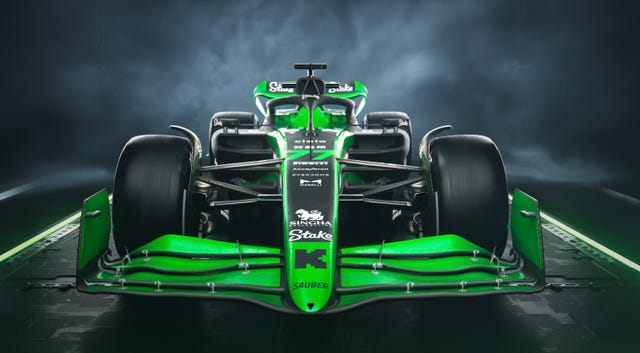
Audience
- Sentiment: Neutral
- Political Group: None
- Age Group: 18-34
- Gender: Male
Overview
- Sauber faces challenges with the performance of their new car, the C45, amid new ground effect regulations.
- The C45 has shown potential but has struggled to maintain competitive pace as the season progressed.
- Audi’s upcoming takeover adds pressure for Sauber to improve and meet high expectations in the competitive Formula 1 landscape.
Sauber and the Challenges of the C45: What’s Going Wrong in Formula 1?
When you think of Formula 1, you probably picture fast cars zooming around the track, drivers skillfully maneuvering at incredible speeds, and teams battling it out not just for race wins but for championships. One team that has had its fair share of ups and downs over the years is Sauber. Most recently, the focus has been on their newly launched car, the C45, which has become a hot topic for fans and analysts alike. As they transition into a full works team for Audi, questions are swirling about whether Sauber has what it takes to keep up with the fierce competition of Formula 1, especially considering the challenges presented by the new ground effect regulations.
A Brief Overview of Sauber
First, let’s talk a bit about Sauber. Founded by Peter Sauber in 1970, the team has long been a part of the Formula 1 landscape. While they started with modest ambitions, over the years, they have built a reputation for being a solid midfield team. However, they have experienced mixed results, occasionally surprising everyone with strong performances, while at other times struggling to keep up. As Sauber prepares to partner with Audi, expectations are high. But the question remains: can they deliver a competitive car?
Ground Effect Regulations: A New Challenge
To understand the challenges Sauber faces, we need to delve a bit into what the ground effect regulations are. Ground effect is a technology that helps a car generate more downforce as it moves, which essentially means the car can grip the road better at high speeds. Think of it like how an airplane’s wing works but turned upside down. Newer regulations in Formula 1 aim to promote closer racing by allowing cars to get closer to each other on the track without losing downforce. It’s a great idea in theory, but it has introduced complications for teams trying to adapt their designs quickly and effectively.
The C45: Expectations vs. Reality
When the C45 was first revealed, there was a wave of cautious optimism among fans and analysts alike. It was expected that the car would perform well, as it had some interesting design features that could give it an edge. The team even managed to score some points in the early races, leading people to believe that they were heading in the right direction.
However, as the season progressed, the initial excitement faded. The C45 struggled to maintain competitive pace against other teams. Performance seemed to lag, and fans were left wondering what went wrong. It became clear that despite the initial promise, the car wasn’t living up to expectations.
Diving Into the Design Details
Now, let’s break down some of the engineering aspects of the C45. One noticeable feature of the car is its pullrod-operated front suspension. In simpler terms, this is a type of suspension that connects the wheel to the chassis in a way that helps with aerodynamics. While the design looks cool and has its advantages, some critics question if this setup is optimal for the current regulations. Was it a design choice that would pay off, or is it hindering the car’s performance?
Additionally, the C45 has various aerodynamic features that were intended to enhance its speed and stability. Sadly, many of these features have not translated into better lap times. For example, the car incorporates a reduced diffuser exit area. The diffuser is an important part of an F1 car’s underbody that helps create downforce, so a smaller exit area might not be the best choice for performance. It raises the question: Are these design features just clever ideas that do not work well in practice?
The Double Floor Concept
Another fascinating aspect of the C45 is its double-floor concept. This design aims to maximize downforce by creating different pressure zones under the car. While on paper this sounds amazing, the reality might be quite different. The complexity of such a design can lead to unpredictable behavior on the track. To put it in a relatable way, imagine building a really intricate LEGO structure that looks great but collapses with the slightest touch. The same could be true for the C45: it may look impressive, but if it can’t keep up with the big boys, what’s the point?
Racing Is a Team Effort
It’s essential to remember that Formula 1 isn’t just about the car. It’s also about the people behind it. The engineers, designers, and mechanics are all crucial in making a car that can compete at the highest level. Team morale and communication within Sauber will also play a vital role as they navigate these challenges. As they say, a chain is only as strong as its weakest link, and in racing, everyone must work seamlessly together to achieve success.
Audi’s Expectations: The Pressure is On
With Audi set to take over Sauber in the coming years, there’s an extra layer of pressure on the team. Audi’s reputation in motorsports is stellar, so naturally, they want to hit the ground running. The question is whether the C45 can evolve into a car that meets Audi’s expectations. Will they have the necessary time and resources to address the current shortcomings? Motorsport is notorious for being ruthless – one day you’re a hero, and the next day you’re being criticized for not making the cut.
The Road Ahead
So what’s next for Sauber? The team knows it has its work cut out for it, especially with new races just around the corner. Continuous improvements are essential, not just for fan excitement but also to satisfy their future partners at Audi. Will they tweak the C45 or revisit some fundamental design ideas? Only time will tell.
Conclusion: A Call for Fan Discussion
As fans of Formula 1, we care about seeing our favorite teams thrive on the racetrack. Sauber has been a staple in the sport for many years, and with changes on the horizon, it can be a thrilling yet challenging time for the team. The engineering debates around the C45 and its design choices can spark incredible discussions about what works and what doesn’t in Formula 1.
With all that said, I want to hear your thoughts! Do you think Sauber can turn things around with the C45, or should they look into a new design altogether? What features do you think are crucial for a competitive car in today’s racing environment? Post a comment below, and let’s dive into this fascinating world of Formula 1 together!




